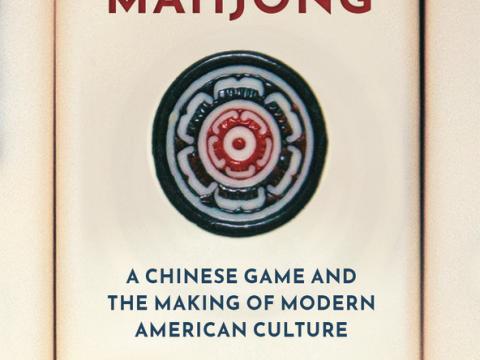
Two faculty members in the history department and one in landscape architecture have penned books that have been named to the Oregon Literary Arts 2022 Book Awards finalist list.
The book awards honor the state’s most accomplished writers in poetry, fiction, nonfiction, young readers and graphic literature. All three of the UO’s nominees are nominated in the general nonfiction category. The winners of each category will be announced April 25.
A Fad That Helped Define American Culture
“Mahjong: A Chinese Game and the Making of Modern American Culture,” by Annelise Heinz, an assistant professor and historian of modern American history, examines the role the Chinese tile-based game played in shaping the modernizing American society of the 1920s, in defining ethnic identities during the Great Depression and after World War II, and in shaping both Chinese American and Jewish American cultures.

The mahjong obsession in the 1920s was an intense fad. Much of the advertising that spread it promoted it as an exciting, exotic pastime.
“It became so popular in part because of the ideas associated with Chinese culture, which resonated with a mostly white American audience as attached to otherness and loosely informed ideas of an ancient Chinese royal court,” Heinz said. “There was a whole performance element around the game; white women would dress up in Chinese-inspired costumes, trying on an alternative persona that they imagined embodied cosmopolitanism and premodern luxury, which contrasted with a modernizing, machine-driven and multiracial society. Mahjong helped resolve some of those tensions, I argue, in this cultural context.”
Variations of the game have popped up wherever mahjong is played, including uniquely American versions. The game caught on again 30 years later among Jewish-American women, a segment of the population that was suburbanizing in the 1950s and ‘60s at four times the national average.
Heinz says that mahjong’s popularity served as a “lifeline” for young mothers in new communities who had often recently left the workforce, building on mahjong’s popularity in Jewish summer vacationing communities.
“What I hope people take from my book is that everyday people make culture,” Heinz said. “It doesn’t happen at a remove. It isn’t only attached to abstract historical changes and massive shifts. Those changes are created and experienced by individuals just like you and me, by the people whose everyday lives are not often written about and captured in archives.
“Looking at a game and the rituals people integrate into their lives is a way to understand the importance of individuals in shaping the world we live in.”
More Than Flavoring: Hops and Community in Oregon
“Hops: Historic Photographs of the Oregon Hopscape,” by Kenneth Helphand, Philip H. Knight emeritus professor of landscape architecture, is both a narrative that includes oral histories and a richly illustrated collection of more than 80 historic photographs from archives around Oregon. The book depicts both the landscape of hopyards and the social history of hop harvesting, an annual event that transcended ethnic group and class.

“My initial interest was in the landscape; what does a ‘hopscape’ look like and how did it get to be that way? In doing the research, I discovered a social and cultural history of hops,” Helphand said. “The picking of hops in the fall was done by hand by tens of thousands of people in the Willamette Valley. Anyone over the age of 70 in Oregon probably picked hops before harvest was mechanized in the 1950s.”
The “agritecture” of hopyards — the striking geometry of poles, twine and emerald garland — is visible to anyone who drives by a field where hops are grown. But the history of why hops are grown where they are, how they are harvested, and what they were before flavoring one of the world’s most popular beverages is lesser known.
“In first part of the 20th century, Oregon’s non-Native American residents were largely first-generation individuals,” Helphand said. “Picking hops was a remarkably democratizing experience. Everyone picked. There are depictions of the banker and the farmer picking irrespective of income or ethnicity. The hop harvest became a meeting ground, similar to the way parks and the beach can be a meeting ground.”
Helphand said his book is a commemoration of an activity that was hard work but had an almost summer camp-like quality to it. After the picking each day, people enjoyed movies and dances. Courtships, too, began among the hop bines.
Helphand notes that the community of hop growers continues even in the printing of the book itself.
“I gave a talk to the Oregon Hop Growers Association at someone’s combination barn/man cave outside of Hubbard and two weeks later the hop growers said they’d help pay to have the book printed,” he said. “From Portland to Grants Pass, there is a connection to hops.”
A Suicide and Fragile Democracy in Shanghai
“The Suicide of Miss Xi: Democracy and Disenchantment in the Chinese Republic,” by Bryna Goodman, a professor and historian of modern China, is based on a 1920s Shanghai court case following the suicide of a woman in a newspaper office, the newly emergent Chinese stock markets and changing ideas about gender, democracy and foreign imperialism.

“The suicide was understood to be a revenge suicide. The accused was pressuring Xi Shangzhen to be his concubine,” Goodman said. “Xi was not potential concubine material (i.e., a purchasable woman), but she was in the emergent and confusing category of ‘new woman,’ which created new vulnerabilities for women in workspaces. The case got me thinking about issues of money, gender and the city in a modernizing China.”
Goodman said her book opens a lively and transnational Chinese public realm to people who may not be familiar with Chinese history. The democratic visions and social formations of early 20th century China, when the country was configured as a republic, may come as a surprise.
“It important to see the possibilities, the contradictions of democracy under semicolonial constraints,” she said. “Some assume China went from an emperor-system to the authoritarian one-party system that exists today. But other potential futures lurked in the possibilities of earlier moments, when notions of democracy infused new economic ideas and ideas of gender in the public realm.”
Goodman used a combination of sources, including print media; police records; British, French and Japanese archives; and Xi’s own writings to untangle the complicated story of the case and its political underside.
“Xi was a cypher,” Goodman said. “Her traces help to illuminate the shaping of urban political identity in China. When you follow a case through and see the messy workings of how power relations work or don’t, it’s a different kind of engagement with history, a window into the surprising possibilities of the time.”
